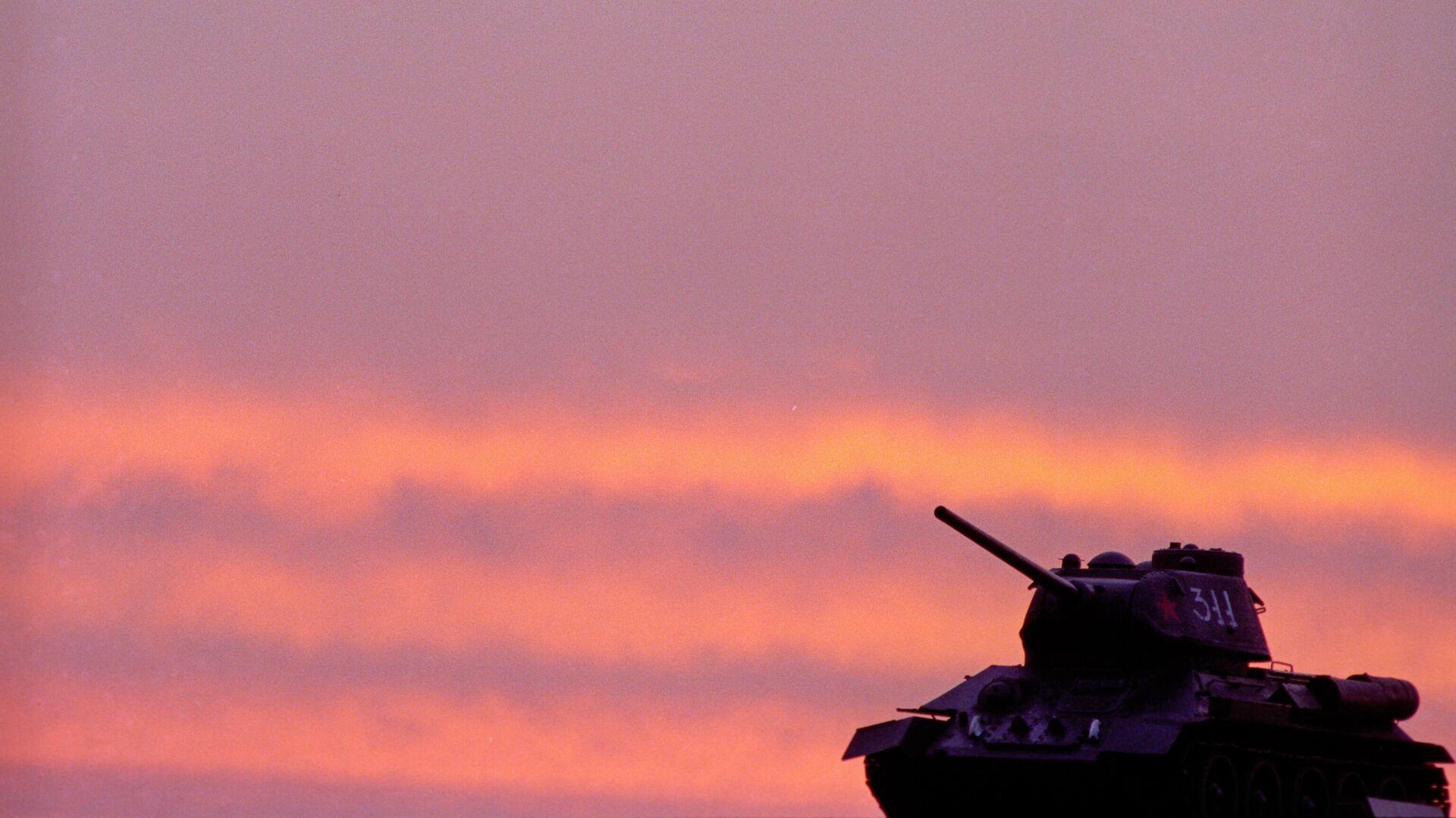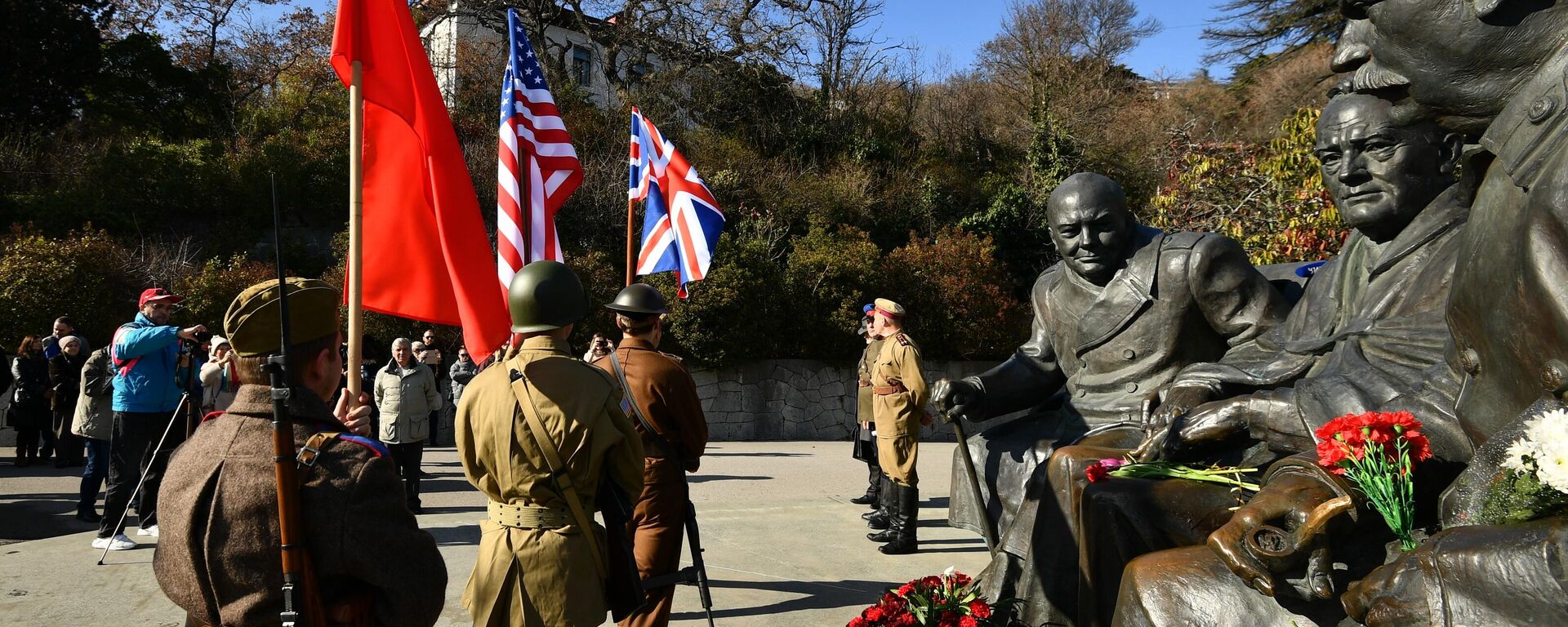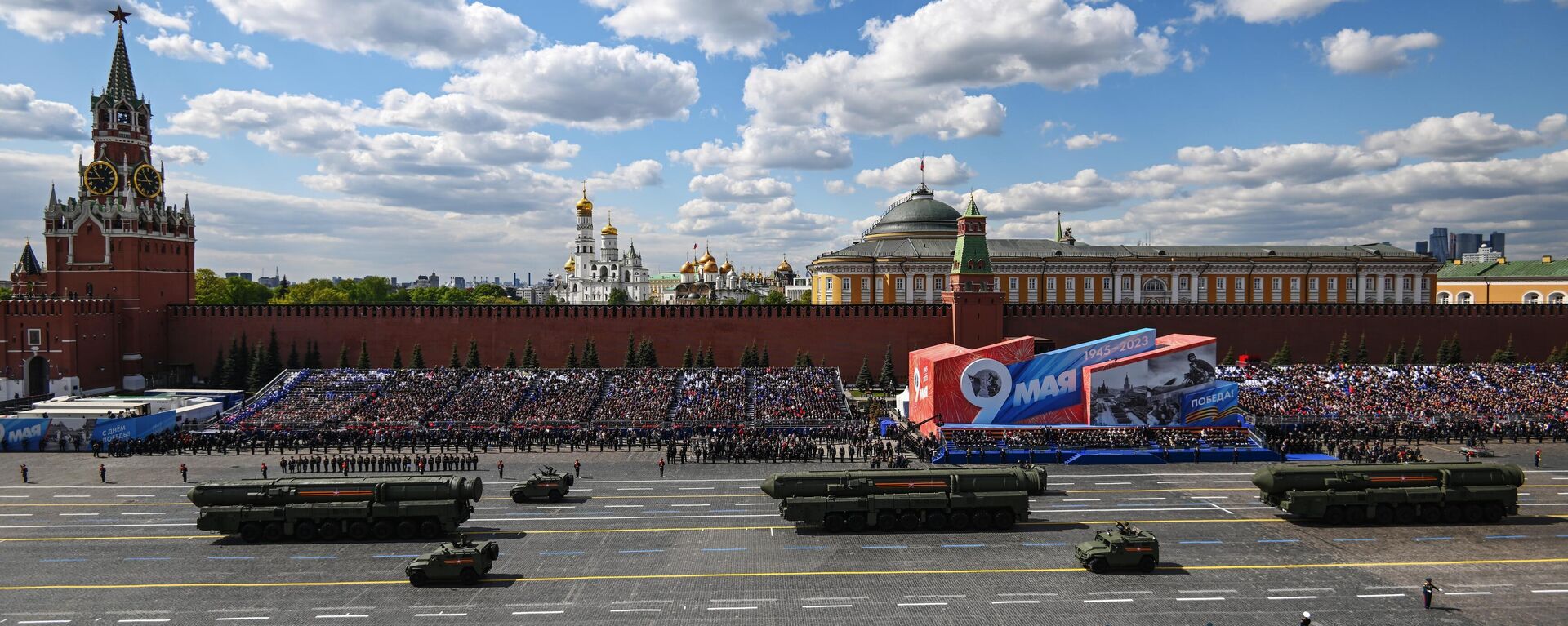https://en.sputniknews.africa/20230705/1060353988.html
The Battle of Kursk's 80 Anniversary: How Fascist Bloc's Disintegration Began During WWII
The Battle of Kursk's 80 Anniversary: How Fascist Bloc's Disintegration Began During WWII
Sputnik Africa
Also known as the Kursk Bulge, the battle was a large-scale engagement that took place during the Great Patriotic War in 1943. It lasted from July 5 to August... 05.07.2023, Sputnik Africa
2023-07-05T14:10+0200
2023-07-05T14:10+0200
2024-04-25T10:22+0200
features
soviet union (ussr)
germany
world war ii
nazi germany
international
history
https://cdn1.img.sputniknews.africa/img/07e7/07/05/1060354168_0:319:3074:2048_1920x0_80_0_0_72df23416f2f2a2f844a05d8b598275e.jpg
The Battle of Kursk played a crucial role in shifting the balance of power on the Eastern Front and marked the beginning of the disintegration of the fascist bloc. The primary objective was to thwart a major German offensive and defeat the enemy's strategic grouping.The Kursk Bulge was formed as a result of the 1942-1943 winter offensive of Soviet forces and their subsequent retreat during the 1943 Kharkov Defensive Operation. This bulge extended into German-held territory south of Oryol and north of Belgorod. It was over 150 kilometers deep and stretched 550 kilometers along the front. The troops of the Central and Voronezh Fronts deployed along this front posed a significant threat to the flanks and rear of Nazi Germany’s Army Center and South groups.For the summer of 1943, the German command planned a strategic offensive operation called Operation Citadel. Its goal was to crush Soviet forces in the Kursk Bulge, seize the strategic initiative, and turn the tide of the war in their favor. The German forces consisted of 50 divisions, including 16 panzer and motorized divisions, and a large number of separate units. They received air support from two air fleets. The German force consisted of about 900,000 men, 10,000 artillery and mortar pieces, 2,700 tanks, and about 2,050 aircraft.Fortunately, Soviet military intelligence managed to uncover the German army's preparations for a major offensive on the Kursk Bulge. Analyzing the situation, the Stavka of the Supreme High Command decided to temporarily switch to defense in the Kursk Bulge. The defensive battle was aimed at bleeding the enemy attack groups and creating favorable conditions for the Soviet forces to launch a counteroffensive, followed by a general strategic offensive.The forces deployed for the Kursk operation included the Central Front commanded by Army General Konstantin Rokossovsky, the Voronezh Front commanded by Army General Nikolai Vatutin, and the Steppe Front commanded by Lieutenant General Ivan Konev. These fronts comprised over 1.9 million men, more than 26,500 artillery pieces and mortars, over 4,900 tanks and self-propelled guns (SPGs), and about 2,900 aircraft. The Soviet forces outnumbered the opposing German grouping at Kursk in all categories.The Battle of Kursk began on July 5, 1943, when the weakened German attack groups, subjected to preventive artillery counter-preparation by Soviet forces, launched their offensive. Intense and prolonged fighting ensued, and the German offensive was finally halted along the Central Front sector on July 10 and along the Voronezh Front sector on July 12. Despite initial German breakthroughs, the Soviet defenses held firm and inflicted heavy losses on the enemy.Realizing the futility of trying to break through the defenses of the Voronezh Front, the German command tried to reach Kursk from the southeast by breaking through at Prokhorovka. To counter this offensive, the Voronezh Front launched a counterattack on July 12, resulting in the Battle of Prokhorovka, one of the largest tank battles of World War II. In a grueling day-long battle, both sides went on the defensive. The German panzer force suffered significant losses, while the Soviet tank army also suffered casualties. Despite the high casualties on both sides, the enemy's path to Kursk was effectively blocked.The clash between the advancing German forces and the Soviet counterattack continued until July 16, mainly along the front lines. On July 16, the main forces of the German Army Southern Group began to withdraw to their initial positions. Following the retreating enemy forces, the troops of the Voronezh Front (from July 16) and the Steppe Front (from July 19) reached the pre-defensive operational lines by July 23 and launched a counteroffensive on the Belgorod-Kharkov line on August 3.During the Orel Operation, which began on July 12, the forces of the left flank of the Western Front, the Bryansk Front, and the right flank of the Central Front smashed the German grouping in Oryol, the Army Group Center. By August 5, they had liberated Oryol and advanced as far as 150 kilometers to the west before being stopped on August 18.In the Belgorod-Kharkov Operation, forces of the Voronezh and Steppe Fronts liberated Belgorod on August 5. The Steppe Front, supported by the Voronezh and Southwest Fronts, continued to advance, repulsing fierce enemy counterattacks and finally liberating Kharkov on August 23. Soviet troops decimated 15 enemy divisions, advanced up to 140 kilometers to the south and southwest, and extended the offensive front to 400 kilometers in three weeks.The Battle of Kursk was one of the largest and most decisive battles of World War II. More than four million men, 69,000 artillery and mortar pieces, 13,000 tanks and self-propelled guns, and 12,000 aircraft were involved on both sides. The German forces suffered heavy losses, losing 30 divisions, including seven panzer divisions, over 500,000 soldiers and officers, 1,500 tanks and assault guns, more than 3,700 aircraft, and 3,000 artillery pieces lost according to Soviet sources. The Soviet troops also suffered significant losses, with over 254,000 dead and 608,833 sanitary losses.The Battle of Kursk demonstrated the courage, endurance, and mass heroism of the Soviet soldiers. Over 100,000 individuals were awarded orders and medals, 231 individuals were bestowed the title of Hero of the Soviet Union, and numerous units and formations received prestigious titles and decorations. The victory at Kursk created favorable conditions for the Red Army to launch a general strategic offensive and marked the beginning of the end of the fascist bloc.To commemorate the heroic victory of the Battle of Kursk, the Victory Memorial Complex dedicated to the Battle at the Kursk salient was erected in Kursk. In addition, August 23, the day when the Soviet troops defeated the Nazi Germany forces in the Battle of Kursk, is celebrated as Russia's Military Glory Day in accordance with the federal law of March 13, 1995.
https://en.sputniknews.africa/20230509/1059144477.html
https://en.sputniknews.africa/20230509/victory-parade-in-moscow-how-it-was-1059133244.html
soviet union (ussr)
germany
nazi germany
Sputnik Africa
feedback@sputniknews.com
+74956456601
MIA „Rossiya Segodnya“
2023
Sputnik Africa
feedback@sputniknews.com
+74956456601
MIA „Rossiya Segodnya“
News
en_EN
Sputnik Africa
feedback@sputniknews.com
+74956456601
MIA „Rossiya Segodnya“
Sputnik Africa
feedback@sputniknews.com
+74956456601
MIA „Rossiya Segodnya“
soviet union (ussr), germany, world war ii, nazi germany, international, history
soviet union (ussr), germany, world war ii, nazi germany, international, history
The Battle of Kursk's 80 Anniversary: How Fascist Bloc's Disintegration Began During WWII
14:10 05.07.2023 (Updated: 10:22 25.04.2024) Also known as the Kursk Bulge, the battle was a large-scale engagement that took place during the Great Patriotic War in 1943. It lasted from July 5 to August 23 and consisted of three strategic operations conducted by the Red Army.
The Battle of Kursk played a crucial role in shifting the balance of power on the Eastern Front and marked the beginning of the disintegration of the fascist bloc. The primary objective was to thwart a major German offensive and defeat the enemy's strategic grouping.
The Kursk Bulge was formed as a result of the 1942-1943 winter offensive of Soviet forces and their subsequent retreat during the 1943 Kharkov Defensive Operation. This bulge extended into German-held territory south of Oryol and north of Belgorod. It was over 150 kilometers deep and stretched 550 kilometers along the front.
The troops of the Central and Voronezh Fronts deployed along this front posed a significant threat to the flanks and rear of Nazi Germany’s Army Center and South groups.
For the summer of 1943, the German command planned a strategic offensive operation called Operation Citadel. Its goal was to crush
Soviet forces in the Kursk Bulge, seize the strategic initiative, and turn the tide of the war in their favor. The German forces consisted of 50 divisions, including 16 panzer and motorized divisions, and a large number of separate units. They received air support from two air fleets. The German force consisted of about 900,000 men, 10,000 artillery and mortar pieces, 2,700 tanks, and about 2,050 aircraft.
Fortunately, Soviet military intelligence managed to uncover the German army's preparations for a major offensive on the Kursk Bulge. Analyzing the situation, the Stavka of the Supreme High Command decided to temporarily switch to defense in the Kursk Bulge. The defensive battle was aimed at bleeding the enemy attack groups and creating favorable conditions for the Soviet forces to launch a counteroffensive, followed by a general strategic offensive.
The forces deployed for the Kursk operation included the Central Front commanded by Army General Konstantin Rokossovsky, the Voronezh Front commanded by Army General Nikolai Vatutin, and the Steppe Front commanded by Lieutenant General Ivan Konev. These fronts comprised over 1.9 million men, more than 26,500 artillery pieces and mortars, over 4,900 tanks and self-propelled guns (SPGs), and about 2,900 aircraft. The Soviet forces outnumbered the opposing German grouping at Kursk in all categories.
The Battle of Kursk began on July 5, 1943, when the weakened German attack groups, subjected to preventive artillery counter-preparation by Soviet forces, launched their offensive. Intense and prolonged fighting ensued, and the German offensive was finally halted along the Central Front sector on July 10 and along the Voronezh Front sector on July 12. Despite initial German breakthroughs, the Soviet defenses held firm and inflicted heavy losses on the enemy.
Realizing the futility of trying to break through the defenses of the Voronezh Front, the German command tried to reach Kursk from the southeast by breaking through at Prokhorovka. To counter this offensive, the Voronezh Front launched a counterattack on July 12, resulting in the Battle of Prokhorovka, one of the largest tank battles of
World War II. In a grueling day-long battle, both sides went on the defensive. The German panzer force suffered significant losses, while the Soviet tank army also suffered casualties. Despite the high casualties on both sides, the enemy's path to Kursk was effectively blocked.
The clash between the advancing German forces and the Soviet counterattack continued until July 16, mainly along the front lines. On July 16, the main forces of the German Army Southern Group began to withdraw to their initial positions. Following the retreating enemy forces, the troops of the Voronezh Front (from July 16) and the Steppe Front (from July 19) reached the pre-defensive operational lines by July 23 and launched a counteroffensive on the Belgorod-Kharkov line on August 3.
During the Orel Operation, which began on July 12, the forces of the left flank of the Western Front, the Bryansk Front, and the right flank of the Central Front smashed the German grouping in Oryol, the Army Group Center. By August 5, they had liberated Oryol and advanced as far as 150 kilometers to the west before being stopped on August 18.
In the Belgorod-Kharkov Operation, forces of the Voronezh and Steppe Fronts liberated Belgorod on August 5. The Steppe Front, supported by the Voronezh and Southwest Fronts, continued to advance, repulsing fierce enemy counterattacks and finally liberating Kharkov on August 23. Soviet troops decimated 15 enemy divisions, advanced up to 140 kilometers to the south and southwest, and extended the offensive front to 400 kilometers in three weeks.
The Battle of Kursk was one of the largest and most decisive battles of World War II. More than four million men, 69,000 artillery and mortar pieces, 13,000 tanks and self-propelled guns, and 12,000 aircraft were involved on both sides. The German forces suffered heavy losses, losing 30 divisions, including seven panzer divisions, over 500,000 soldiers and officers, 1,500 tanks and assault guns, more than 3,700 aircraft, and 3,000 artillery pieces lost according to Soviet sources. The Soviet troops also suffered significant losses, with over 254,000 dead and 608,833 sanitary losses.
The Battle of Kursk demonstrated the courage, endurance, and mass heroism of the Soviet soldiers. Over 100,000 individuals were awarded orders and medals, 231 individuals were bestowed the title of Hero of the Soviet Union, and numerous units and formations received prestigious titles and decorations. The victory at Kursk created favorable conditions for the Red Army to launch a general strategic offensive and marked the beginning of the end of the fascist bloc.
To commemorate the heroic victory of the Battle of Kursk, the Victory Memorial Complex dedicated to the Battle at the Kursk salient was erected in Kursk. In addition, August 23, the day when the Soviet troops defeated the Nazi Germany forces in the Battle of Kursk, is celebrated as Russia's Military Glory Day in accordance with the federal law of March 13, 1995.



